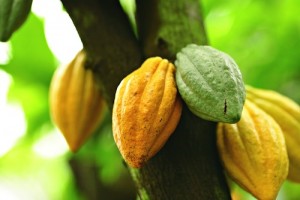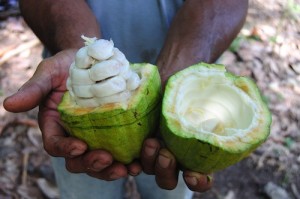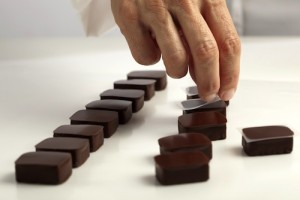Since 1500 BC, people have enjoyed chocolate. Historians believe that the first people to use cocoa were the Mayans. However, it was only enjoyed as a beverage until more than a thousand years passed when we discovered how chocolate is made. Francois Louis Cailler, of Switzerland, made the first chocolate bar in 1819, which could be why the Swiss are still known for their high quality chocolate. So how is it made as we know it today?
Chocolate comes from cacao beans that grow on the Theobroma cacao tree. Most people just call them cacao trees. The beans are packed densely into the seedpods from this tree.
The first step in chocolate making is harvesting the cocoa pods, which look like yellow footballs. Those pods hang off of cacao trees, which grow best in the hot, humid countries of Asia, Africa, South America, and Central America.
Fermentation
Once harvested from the pods, the white cocoa beans and pulp are fermented in wooden containers for 5-7 days. Harvesters turn them over often for an even fermentation.
Drying
Once the beans have fermented, they must spread out in a single layer to dry in the sun. As the beans dry, they go from white to the dark brown color that we’re familiar with.
Thorough sun drying is imperative, to protect the crop from mold on their long journey to chocolatiers around the world, such as Asher’s Chocolates. Sun drying also produces the best flavor.
Roasting
Roasting is the manufacturer’s first step in processing chocolate. Chocolate makers use many types of equipment to roast the cocoa beans. Some use a standard oven, and others use cooking equipment specially made to their unique specification.
The roasting process and length of the roast are part of each chocolatier’s unique recipe. That is why many manufacturers of chocolate keep the roasting time and temperature a secret – finding just the right time and temperature requires much experimentation and tasting.
Cracking and Winnowing
The beans are still not ready for cooking just yet. Roasting leaves the cocoa beans with a thin shell that is like paper. Before more processing happens, the flimsy shell has to come off.
The way to remove the papery shell is a process called winnowing. Machines crack the beans open. Then powerful fans blow over the beans and its shells carrying the lighter shells away and leaving behind pure cocoa pieces called nibs.
Grinding and Conching
The cocoa nibs move to a grinder that grinds them into a paste known as cocoa mass or cocoa liquor. The manufacturer now has pure, unrefined chocolate has cocoa solids (this is the chocolaty part) and cocoa butter has the natural fat found in the cocoa bean.
To remove the cocoa butter from the cocoa mass, manufacturers use a hydraulic press. Later in the process, the manufacturer often adds back the cocoa butter as extra cocoa butter makes chocolate have a slicker, shinier texture.
At this point, the cocoa mass moves to another machine called a conch. Conching further refines the chocolate mass with continued grinding. It is at this stage in manufacturing where the maker adds more ingredients such as sugar, milk powder (only if making milk chocolate) and other ingredients and flavorings.
Each chocolate maker has his or her own preferred time for conching. It can be as little as a few hours or as long as a few days. The process affects the size of the particles in the chocolate when finished, and the chemical structure of the chocolate, which affects the flavor of the product.
Tempering
Excellent chocolate such as Asher’s Chocolate makes a snapping sound when you break off a piece. Finishes are shiny as well. These qualities come from a process called tempering. It is a process where the temperature of the chocolate rises and falls. Untempered chocolate is crumbly and soft and does not melt on your tongue in an even way.
Molding
The finished chocolate bar is almost complete. The last step is to pour the melted chocolate into molds, where, once cooled, the finished chocolate is packaged for your shopping cart.
Making great chocolate is similar to making great wine or outstanding beer. It is both chemistry and an art. Brewers are the artisans that make great wine and beer; chocolatiers blend outstanding chocolates.
Asher’s Chocolates is a family-owned chocolate maker in the business since 1892. Our state-of-the-art chocolate making facility is in Souderton, Pennsylvania and is open to the public for tours. Call us at 800-438-8882 to check if we are open for touring when you are in the area. Tours are always free.



